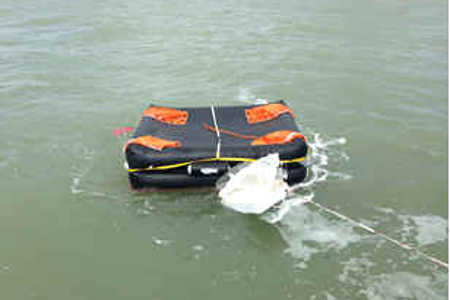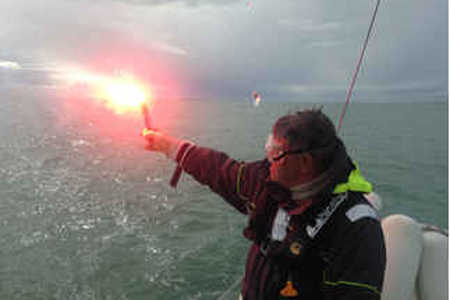Sailing at sea involves a number of dangers that are not easy to grasp for beginners in the practice of sailing.
On a sailboat, the risk of accidents is heightened by the power of the forces at play on the ropes or rigging.
A rope that runs poorly or a clutch that fails can cause serious accidents, especially in strong winds and rough seas. In terms of safety, both a lack and an excess of confidence are equally dangerous.
To strike the right balance, one must of course remain vigilant at all times but also keep a few key points in mind, starting with the statistics.


If about a quarter of rescue requests involve sailboats, more than half of these interventions are due to engine failure. However, a sailboat, by definition, can usually return under sail, at least to the port entrance.
Since towing from the channel is free in many harbormaster's offices, relying on port services would save volunteer rescuers a lot of unnecessary trouble... Another way to prevent engine failures is, of course, to check its condition before departure.
Many boat rental companies operate on a tight schedule during the summer season and don’t always take the time to perform thorough maintenance. On the other hand, renters often tend to rely on the responsibility of the rental company. Negligence, when it gets the better of us...
Other common causes of sea rescues are more varied. They include navigation difficulties, fouled propellers, groundings (a grounding being intentional), or mooring issues. All these elements remind us of the importance of proper preparation before setting out.
Première base de la navigation, prendre correctement la météo marine. Si votre smartphone est en panne, les prévisions côtières sont affichées dans les capitaineries. Sinon, Internet permet très facilement de croiser les sources de bulletins météo. Une bonne aide pour se faire une idée la plus précise possible de ce à quoi on doit s'attendre une fois dehors.
Bien sûr il ne suffit pas de connaître les conditions de départ, mais si possible celles du retour. Si vous risquez de rester bloqué dans tel ou tel port à cause d'une mauvaise météo, mieux vaut peut-être changer d'option.
Enfin, si le temps annoncé vous met mal à l'aise, mieux vaut rester au port plutôt que de prendre des risques inconsidérés ou de les imposer aux gens dont vous avez la responsabilité.
Once at sea, you must be able to rely on yourself and your crew in case of an accident.
The key maneuver to know is, of course, the "man overboard" procedure. While rare, it is serious enough to require every sailor to master the recovery process. Your mission, should you choose to accept it, will be to practice this maneuver every time you take a boat, as it varies greatly depending on the conditions...
Beyond the man overboard procedure, you will need to familiarize yourself with safety maneuvers. These will help protect you in cases of strong winds or rough seas, which are not particularly rare during long passages. Of course, this doesn’t happen overnight. Mastery of these maneuvers requires repetition until they become second nature.
If, on the other hand, conditions become particularly dangerous, you won’t regret knowing points of sail for safety.
In a Force 10 wind with 8-meter swells, it’s always helpful to know how to heave to, deploy sea drogues, or set a sea anchor.
Along the same lines, we strongly encourage you to learn how to handle a liferaft. Reading the manual is one thing; using it under stressful conditions, where you lose 50% of your abilities, is another!
You’ll need to learn how to deploy it, board safely, and then urgently gather resources for drinking, eating, staying warm, washing, and communicating...
It’s quite a program, and it’s better to have thought it through before facing such a situation.
For amateur or professional skippers wishing to participate in offshore racing events, World Sailing courses (formerly ISAF) teach, through a combination of classroom theory and onboard practice, the right reflexes to adopt in heavy weather offshore.
They result in a certificate valid for 5 years, accredited by the French Sailing Federation.
Another important step towards safe sailing is learning how to properly manage fires on board. In some cases, you only have a few seconds to react.
Adopt the right reflexes for a galley fire, an electrical fire, or an engine fire. Learn to identify different types of fire extinguishers and understand the legal obligations for boaters regarding fire prevention and control.
It is an expertise that, during courses primarily focused on safety, will allow you to:
* Prevent nautical risks by mastering all situations requiring a detailed analysis of your navigations.
* Anticipate and use suitable and compliant tools to navigate safely, combining technique and enjoyment.
Sailing at sea involves a number of dangers that are not easy to grasp for beginners in the practice of sailing.
On a sailboat, the risk of accidents is heightened by the power of the forces at play on the ropes or rigging.
A rope that runs poorly or a clutch that fails can cause serious accidents, especially in strong winds and rough seas. In terms of safety, both a lack and an excess of confidence are equally dangerous.
To strike the right balance, one must of course remain vigilant at all times but also keep a few key points in mind, starting with the statistics.


If about a quarter of rescue requests involve sailboats, more than half of these interventions are due to engine failure. However, a sailboat, by definition, can usually return under sail, at least to the port entrance.
Since towing from the channel is free in many harbormaster's offices, relying on port services would save volunteer rescuers a lot of unnecessary trouble... Another way to prevent engine failures is, of course, to check its condition before departure.
Many boat rental companies operate on a tight schedule during the summer season and don’t always take the time to perform thorough maintenance. On the other hand, renters often tend to rely on the responsibility of the rental company. Negligence, when it gets the better of us...
Other common causes of sea rescues are more varied. They include navigation difficulties, fouled propellers, groundings (a grounding being intentional), or mooring issues. All these elements remind us of the importance of proper preparation before setting out.
Première base de la navigation, prendre correctement la météo marine. Si votre smartphone est en panne, les prévisions côtières sont affichées dans les capitaineries. Sinon, Internet permet très facilement de croiser les sources de bulletins météo. Une bonne aide pour se faire une idée la plus précise possible de ce à quoi on doit s'attendre une fois dehors.
Bien sûr il ne suffit pas de connaître les conditions de départ, mais si possible celles du retour. Si vous risquez de rester bloqué dans tel ou tel port à cause d'une mauvaise météo, mieux vaut peut-être changer d'option.
Enfin, si le temps annoncé vous met mal à l'aise, mieux vaut rester au port plutôt que de prendre des risques inconsidérés ou de les imposer aux gens dont vous avez la responsabilité.
Once at sea, you must be able to rely on yourself and your crew in case of an accident.
The key maneuver to know is, of course, the "man overboard" procedure. While rare, it is serious enough to require every sailor to master the recovery process. Your mission, should you choose to accept it, will be to practice this maneuver every time you take a boat, as it varies greatly depending on the conditions...
Beyond the man overboard procedure, you will need to familiarize yourself with safety maneuvers. These will help protect you in cases of strong winds or rough seas, which are not particularly rare during long passages. Of course, this doesn’t happen overnight. Mastery of these maneuvers requires repetition until they become second nature.
If, on the other hand, conditions become particularly dangerous, you won’t regret knowing points of sail for safety.
In a Force 10 wind with 8-meter swells, it’s always helpful to know how to heave to, deploy sea drogues, or set a sea anchor.
Along the same lines, we strongly encourage you to learn how to handle a liferaft. Reading the manual is one thing; using it under stressful conditions, where you lose 50% of your abilities, is another!
You’ll need to learn how to deploy it, board safely, and then urgently gather resources for drinking, eating, staying warm, washing, and communicating...
It’s quite a program, and it’s better to have thought it through before facing such a situation.
For amateur or professional skippers wishing to participate in offshore racing events, World Sailing courses (formerly ISAF) teach, through a combination of classroom theory and onboard practice, the right reflexes to adopt in heavy weather offshore.
They result in a certificate valid for 5 years, accredited by the French Sailing Federation.
Another important step towards safe sailing is learning how to properly manage fires on board. In some cases, you only have a few seconds to react.
Adopt the right reflexes for a galley fire, an electrical fire, or an engine fire. Learn to identify different types of fire extinguishers and understand the legal obligations for boaters regarding fire prevention and control.
It is an expertise that, during courses primarily focused on safety, will allow you to:
* Prevent nautical risks by mastering all situations requiring a detailed analysis of your navigations.
* Anticipate and use suitable and compliant tools to navigate safely, combining technique and enjoyment.